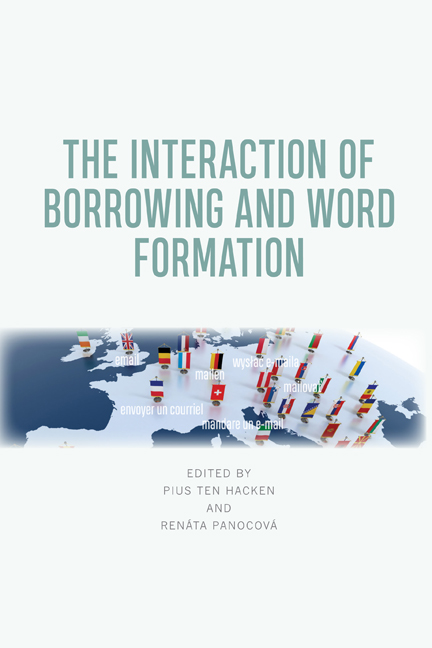Book contents
- Frontmatter
- Contents
- List of Figures and Tables
- List of Contributors
- Preface
- List of ISO-639 Language Codes
- Introduction
- 1 Word Formation, Borrowing and their Interaction
- Part I Compounding
- 2 Compounding and Contact
- 3 Neoclassical Compounds between Borrowing and Word Formation
- 4 Borrowed Compounds, Borrowed Compounding – Portuguese Data
- 5 Compound Calques in an Eighteenth-Century German-Lithuanian Dictionary
- 6 (Pseudo-)Anglicisms as Nominal Compounds in Italian
- Part II Affixation
- 7 The Role of Borrowing in the Derivation of Passive Potential Adjectives in Polish
- 8 How an ‘Italian’ Suffix Became Productive in Germanic Languages
- 9 The Suffixes -ismus and -ita in Nouns in Czech
- 10 The Interaction between Borrowing and Word Formation: Evidence from Modern Greek Prefixes
- Part III Naming in Minority Languages
- 11 Loanword Formation in Minority Languages: Lexical Strata in Titsch and Töitschu
- 12 Examining the Integration of Borrowed Nouns in Immigrant Speech: The Case of Canadian Greek
- 13 Interaction among Borrowing, Inflection and Word Formation in Polish Medieval Latin
- Conclusion
- 14 Trends in the Interaction between Borrowing and Word Formation
- Author Index
- Subject Index
5 - Compound Calques in an Eighteenth-Century German-Lithuanian Dictionary
Published online by Cambridge University Press: 22 September 2020
- Frontmatter
- Contents
- List of Figures and Tables
- List of Contributors
- Preface
- List of ISO-639 Language Codes
- Introduction
- 1 Word Formation, Borrowing and their Interaction
- Part I Compounding
- 2 Compounding and Contact
- 3 Neoclassical Compounds between Borrowing and Word Formation
- 4 Borrowed Compounds, Borrowed Compounding – Portuguese Data
- 5 Compound Calques in an Eighteenth-Century German-Lithuanian Dictionary
- 6 (Pseudo-)Anglicisms as Nominal Compounds in Italian
- Part II Affixation
- 7 The Role of Borrowing in the Derivation of Passive Potential Adjectives in Polish
- 8 How an ‘Italian’ Suffix Became Productive in Germanic Languages
- 9 The Suffixes -ismus and -ita in Nouns in Czech
- 10 The Interaction between Borrowing and Word Formation: Evidence from Modern Greek Prefixes
- Part III Naming in Minority Languages
- 11 Loanword Formation in Minority Languages: Lexical Strata in Titsch and Töitschu
- 12 Examining the Integration of Borrowed Nouns in Immigrant Speech: The Case of Canadian Greek
- 13 Interaction among Borrowing, Inflection and Word Formation in Polish Medieval Latin
- Conclusion
- 14 Trends in the Interaction between Borrowing and Word Formation
- Author Index
- Subject Index
Summary
Compound calques are a widespread type of structural borrowing that was created by an item-by-item translation of the source compound (cf. the definition of calque in general, Haspelmath 2009: 39). In this chapter, I distinguish between absolute compound calques, i.e. item-by-item copies of donor language compounds, including both the pattern of a compound and the semantics of its members, and non-absolute (or creative) compound calques that have differences in the semantics of one member, in the pattern of the compound, or in both.
This chapter has been divided into five sections. Section 1 introduces the data, research methods and aim, while section 2 discusses the sociolinguistic and cultural situation in East Prussia in the eighteenth century. Section 3 presents nominal compounding in the eighteenth-century German-Lithuanian dictionary by Jacob Brodowski, including the overall characteristics of Lithuanian compounds and their German equivalents. Section 4, which is central to this chapter, presents research on Lithuanian determinative, possessive and verbal governing compound calques in the said dictionary. The chapter ends with the conclusions (section 5).
The data, research methods and aim
The material for this chapter is taken from an eighteenth-century manuscript, the German-Lithuanian Dictionary by Jacob Brodowski (1011 pp., ∼1744, hereafter referred to as B); the documentary edition containing a facsimile, transcript and word register was published in 2009 (see Drotvinas 2009). The compiler of the dictionary, Jacob Brodowski (LT Jokūbas Brodovskis, ∼1692–1744), studied at Konigsberg University. From 1713 until his death, he was a teacher at a church school in the parish of Trempai (DE Trempen, currently Novostrojevo, Kaliningrad district, Russia) in the eastern part of the Duchy of Prussia, which used to be called Lithuania Minor as opposed to Lithuania Major, a territory of the United Polish-Lithuanian Commonwealth inhabited by Lithuanians (for more see Zinkevičius 1996: 272; Drotvinas 2009: I, XXI–XXIII). It is unclear whether Brodowski's native language was Lithuanian, Polish or even German (he could have descended from an ethnically mixed family), nevertheless his Lithuanian and German were proficient (for more see Plaušinaitytė 2010: 43–46).
- Type
- Chapter
- Information
- The Interaction of Borrowing and Word Formation , pp. 67 - 85Publisher: Edinburgh University PressPrint publication year: 2020



